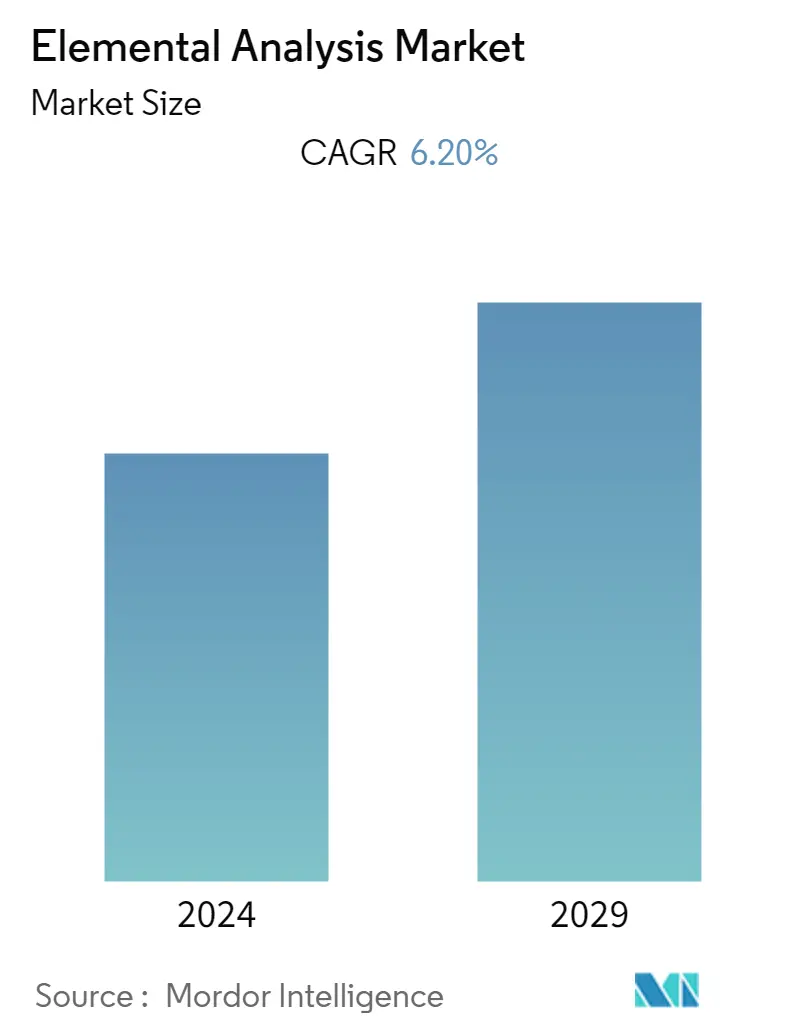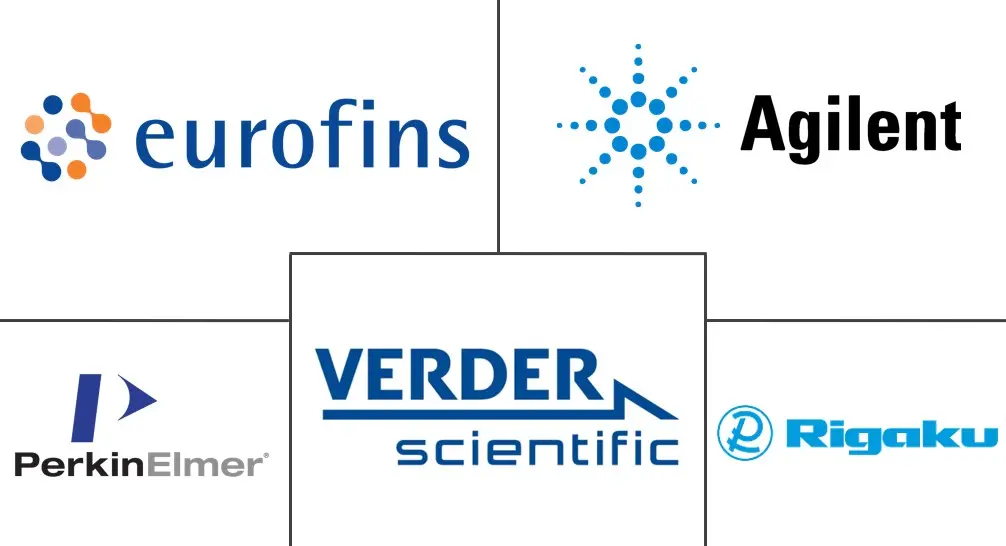Market Size of Elemental Analysis Industry

| Study Period | 2021 - 2029 |
| Base Year For Estimation | 2023 |
| CAGR | 6.20 % |
| Fastest Growing Market | Asia Pacific |
| Largest Market | North America |
| Market Concentration | Low |
Major Players
*Disclaimer: Major Players sorted in no particular order |
Elemental Analysis Market Analysis
The elemental analysis market is expected to register a CAGR of 6.2% over the forecast period.
The elemental analysis market was significantly impacted by the COVID-19 pandemic. In the case of COVID-19 patients, there was an abnormal amount of trace elements in the body, and the respiratory system was at risk of infection due to the higher concentrations of heavy metals in the blood. For instance, as per the study report published by the American Journal of Analytical Chemistry in May 2021, the elemental analysis in COVID-19 patients was performed using an atomic absorption (AA) spectrophotometer, which revealed that COVID-19 patients have abnormal levels of essential trace metals (zinc, iron, and copper) versus toxic elements (cadmium and nickel) in the biological samples. As a result of the COVID-19 effect on elements in the bloodstream, the demand for elemental analysis was significant, which drove the market's growth during the pandemic phase. Currently, the number of COVID-19 cases is relatively low throughout the world; its impact on the market is stable, and the trend is expected to continue due to the ongoing research activities on COVID-19 and emerging viral strains, as per the analysis.
Over the forecast period, the major growth drivers of the elemental analysis market are growing research and development funding in life sciences and mandated government regulations for elemental analysis of pharmaceutical and healthcare products. According to the National Institutes of Health (NIH), Estimates of Funding for Various Research Categories in 2022, it is estimated that the clinical research funding under the life sciences in the United States for 2021 was USD 17,681 million, and it is expected to increase to USD 18,405 million in 2022 and USD 18,383 million in 2023. Thus, the gradual rise in research and development funding is expected to positively impact the market over the forecast period, as elemental analysis is one of the techniques used in clinical research for testing samples of body fluids.
Furthermore, in August 2022, Analytik Jena published that, in a few years, Germany's legislation will make phosphorus recovery from sewage sludge mandatory. The Analytik Jena PlasmaQuant 9100 ICP-OES instrument detects the included nutrients and essential elements in a single measurement cycle, eliminating the need for time-consuming analysis.
However, a lack of skilled personnel is expected to restrain the elemental analysis market's growth during the forecast period.
Elemental Analysis Industry Segmentation
Elemental analysis helps in the quantitative and qualitative identification of various elements in various areas, such as life sciences, food and beverage testing, environment testing, geology, cosmetics testing, and petroleum. Elemental analysis can be performed on a solid, liquid, or gas. The Elemental Analysis Market is segmented by Type (Organic Elemental Analysis and Inorganic Elemental Analysis), Technology (Destructive Technologies (Inductively Coupled Plasma-Atomic Emission Spectroscopy (ICP-AES), Inductively Coupled Plasma-Mass Spectroscopy (ICP-MS), Combustion Analysis and Others) and Nondestructive Technologies (X-Ray Fluorescence Spectroscopy (XRF), Fourier Transform Infrared Spectroscopy (FTIR), and Others)), End User (Pharmaceutical and Biotechnology Companies, Research Organizations, and Others), and Geography (North America, Europe, Asia-Pacific, Middle East & Africa, and South America). The report also covers the estimated market sizes and trends for 17 countries across major regions globally. The report offers the value (in USD million) for the above segments.
| By Type | |
| Organic Elemental Analysis | |
| Inorganic Elemental Analysis |
| By Technology | ||||||
| ||||||
|
| By End User | |
| Pharmaceutical and Biotechnology Companies | |
| Research Organizations | |
| Others |
| Geography | ||||||||
| ||||||||
| ||||||||
| ||||||||
| ||||||||
|
Elemental Analysis Market Size Summary
The elemental analysis market is poised for steady growth, driven by increasing research and development funding in life sciences and stringent government regulations mandating elemental analysis in pharmaceuticals and healthcare products. The market experienced a significant boost during the COVID-19 pandemic due to the abnormal trace element levels observed in infected patients, which heightened the demand for elemental analysis. This trend is expected to continue as ongoing research into COVID-19 and emerging viral strains persists. The market's expansion is further supported by advancements in analytical technologies and regulatory requirements, such as those in Germany, which mandate phosphorus recovery from sewage sludge, highlighting the importance of elemental analysis in environmental and industrial applications.
North America is anticipated to lead the global elemental analysis market, attributed to its advanced technological developments and diverse application areas, including healthcare, pharmaceuticals, and food and beverage industries. The rising prevalence of chronic kidney disease (CKD) in the region underscores the growing need for elemental analysis to monitor trace element levels in patients. The market is moderately competitive, with key players like Thermo Fisher Scientific, PerkinElmer, and Agilent Technologies focusing on innovation to meet evolving market demands. Recent product launches, such as Analytik Jena's updated ICP-MS systems and SPECTRO Analytical Instruments' OES analyzer, exemplify the industry's commitment to enhancing analytical capabilities and addressing the needs of various sectors.
Elemental Analysis Market Size - Table of Contents
-
1. MARKET DYNAMICS
-
1.1 Market Overview
-
1.2 Market Drivers
-
1.2.1 Growing R&D Funding in Life Sciences
-
1.2.2 Mandating Government Regulations for Elemental Analysis of Pharmaceutical and Healthcare Products
-
-
1.3 Market Restraints
-
1.3.1 Lack of Skilled Personnel
-
-
1.4 Porter's Five Forces Analysis
-
1.4.1 Threat of New Entrants
-
1.4.2 Bargaining Power of Buyers/Consumers
-
1.4.3 Bargaining Power of Suppliers
-
1.4.4 Threat of Substitute Products
-
1.4.5 Intensity of Competitive Rivalry
-
-
-
2. MARKET SEGMENTATION (Market Size by Value - USD million)
-
2.1 By Type
-
2.1.1 Organic Elemental Analysis
-
2.1.2 Inorganic Elemental Analysis
-
-
2.2 By Technology
-
2.2.1 Destructive Technologies
-
2.2.1.1 Inductively Coupled Plasma-Atomic Emission Spectroscopy (ICP-AES)
-
2.2.1.2 Inductively Coupled Plasma-Mass Spectroscopy (ICP-MS)
-
2.2.1.3 Combustion Analysis
-
2.2.1.4 Others
-
-
2.2.2 Nondestructive Technologies
-
2.2.2.1 X-Ray Fluorescence Spectroscopy (XRF)
-
2.2.2.2 Fourier Transform Infrared Spectroscopy (FTIR)
-
2.2.2.3 Others
-
-
-
2.3 By End User
-
2.3.1 Pharmaceutical and Biotechnology Companies
-
2.3.2 Research Organizations
-
2.3.3 Others
-
-
2.4 Geography
-
2.4.1 North America
-
2.4.1.1 United States
-
2.4.1.2 Canada
-
2.4.1.3 Mexico
-
-
2.4.2 Europe
-
2.4.2.1 Germany
-
2.4.2.2 United Kingdom
-
2.4.2.3 France
-
2.4.2.4 Italy
-
2.4.2.5 Spain
-
2.4.2.6 Rest of Europe
-
-
2.4.3 Asia-Pacific
-
2.4.3.1 China
-
2.4.3.2 Japan
-
2.4.3.3 India
-
2.4.3.4 Australia
-
2.4.3.5 South Korea
-
2.4.3.6 Rest of Asia-Pacific
-
-
2.4.4 Middle-East and Africa
-
2.4.4.1 GCC
-
2.4.4.2 South Africa
-
2.4.4.3 Rest of Middle-East and Africa
-
-
2.4.5 South America
-
2.4.5.1 Brazil
-
2.4.5.2 Argentina
-
2.4.5.3 Rest of South America
-
-
-
Elemental Analysis Market Size FAQs
What is the current Elemental Analysis Market size?
The Elemental Analysis Market is projected to register a CAGR of 6.20% during the forecast period (2024-2029)
Who are the key players in Elemental Analysis Market?
Eurofins Scientific, Agilent Technologies, Inc., Rigaku Corporation, Verder Scientific GmbH & Co. KG (ELTRA GmbH) and PerkinElmer Inc are the major companies operating in the Elemental Analysis Market.

